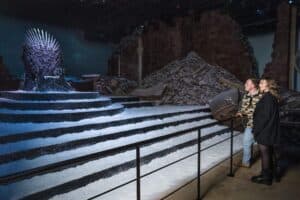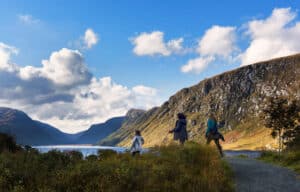Britain boasts a treasure trove of castles. While many lie in ruins, countless others have undergone extensive restoration and refurbishment across centuries, to become major tourist attractions, historical landmarks and hotels. Here, we have selected our favourite castles in Britain, which provide tourists with a multifaceted experience, combining natural beauty, heritage and history!
1. Windsor Castle
Aside from its wonderful architecture, Windsor Castle is notable for its long association with the British royal family. This castle was originally designed to protect Norman dominance around the outskirts of London and to oversee a strategically important part of the River Thames. Henry III built a luxurious royal palace within Windsor Castle during the middle of the 13th century. Following a period of neglect in the 18th century, it was renovated and rebuilt in its current state. The royal family took refuge in Windsor Castle during the Second World War. It’s popularity is a testament to its cultural significance and the interest it holds for visitors. It is the perfect opportunity for a glimpse into the lives of the Royal family. Immerse yourself in this rich, cultural experience all while viewing it’s stunning surroundings.
2. Caernarfon Castle
While Wales has many castles to explore, Caernarfon Castle is the standout, a true must-see. It exudes a strength and majesty that is often missing from many castles and that is no accident. Caernarfon Castle was built to mirror the walls of Constantinople, the capital of the Roman Empire. Despite Caernarfon Castle’s external appearance of being mostly complete, the interior buildings no longer survive and many of the building plans were never finished. The town and castle were sacked in 1294 when Madog ap Llywelyn led a rebellion against the English. Caernarfon was recaptured the following year. Since 1986, Caernarfon has been part of the UNESCO list of World Heritage Sites. So, when you walk through Caernarfon Castle, you’re not only exploring old walls, you are stepping into a place where history comes to life. You can almost feel the stories of the past here. This is a gem that’s worth discovering!
3. Alnwick Castle 
Alnwick Castle was built following the Norman conquest, and has seen many changes throughout the years. It is the seat of the Duke of Northumberland. You might recognize it as Hogwarts in the Harry Potter films, which has increased people’s curiosity and it has changed how we picture castles. Adjacent to the castle, The Alnwick Garden is a formal garden set around a cascading fountain. This is no ordinary garden as it costs £42 million and belongs to a charitable trust. Alnwick Castle receives more than 800,000 visitors per year. It is the perfect place to visit if you would like to witness history and magic come together.
4. Stirling Castle
Stirling Caste is one of the most important and largest castles in Scotland. The castle sits atop a hill and is surrounded on three sides by steep cliffs, giving it a formidable defensive position. It’s not just like any other castle, it is a true powerhouse! Stirling Castle is not just a pile of stones, but a symbol of Scottish independence and a source of national pride and will provide you as a tourist with a deep understanding of Scottish identity. Famous historical figures such as William Wallace and Mary, Queen of Scots have had a hand in its story and are part of its thrilling history. The turbulent history behind Stirling castle is one of intrigue, drama and political power struggles and offers a rich, educational experience to its tourists.
5. Highclere Castle
Highclere Castle is a country house in the Jacobethan style. The sprawling 1,000-acre estate is in Hampshire, England. It is where the Earl of Carnarvon hangs his hat and is most famous as the main filming location for the beloved British television period drama Downton Abbey. The writer of the show, Julian Fellowes, had Highclere Castle in mind as he wrote Downton Abbey and often commented he wanted a house which spectacularly testified to the confidence and soaring optimism of the Edwardian period. A dramatic increase in the number of paying visitors, thanks to Downton Abbey, has allowed them to begin major repairs both on Highclere’s turrets and its interior. The family now lives in Highclere during the winter months, but in the summer, they head to their cottage, and that’s when you can step inside and explore the castle for yourself. It is like you are stepping right into Downtown Abbeys world. This is an incredible experience that you do not want to miss out on.
6. Warwick Castle 
The history of the magnificent medieval fortification known as Warwick Castle dates back to 1068, when William the Conqueror first built it. The original wooden motte-and-bailey castle was rebuilt in stone in the 12th century. Over its 950 years of history, Warwick Castle has been owned by 36 different individuals, plus four periods as crown property under seven different monarchs. What’s really fascinating is that 11 of these owners were just kids, including a two year old girl and a three year old boy when they inherited the castle. At least three owners died in battle, two were executed and one murdered. Here, there are interactive attractions, such as archery displays and jousting tournaments. It’s incredible picturesque landscape and medieval architecture blend both history and natural beauty together. It is fair to say this place is bursting with rich history and visiting it is like stepping straight back in time into a medieval adventure!
7. Edinburgh Castle
Majestically perched atop Castle Rock, Edinburgh Castle dominates the skyline of the city of Edinburgh. There has been a royal castle here since at least the 12th century. As one of the most important fortresses in the Kingdom of Scotland, Edinburgh Castle was involved in many historical conflicts, from the Wars of Scottish Independence in the 14th century, up to the Jacobite Rising of 1745, and has been besieged several times. Edinburgh Castle is Scotland’s most-visited, paid tourist attraction with over 1.3 million visitors in 2011. As the backdrop to the annual Edinburgh Military Tattoo, it has become a recognizable symbol of Edinburgh and of Scotland. Edinburgh Castle provides tourists with a trip through time and an immersion into Scotlands incredible history and culture. This is a paradise for photographers, history enthusiasts or someone who is simply seeking a memorable day out.





